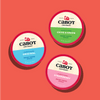
Greek Yogurt vs Regular Yogurt - Here's the Difference
Yogurt is an incredibly popular dairy product. In 2020, Americans spent more than $7 billion on yogurt, and around 45% of those sales were Greek yogurt. Thanks to its unique flavor, Greek yogurt continues to grow in popularity, leading more and more people to wonder "what is Greek yogurt vs regular yogurt?" This guide will break down the differences and similarities between the two delicious foods and review the nutrients and health benefits of yogurt.
How is yogurt made?
Regular and Greek yogurt begins the same way--with fresh milk. Cabot's farmers use only pure milk to ensure smoothness and richness in our yogurts, but dairies may also combine other things with the milk base in some cases. What is the same among all brands is the starter culture made up of beneficial bacteria. Once mixed with fresh milk, the starter begins turning the naturally occurring lactose sugar in milk into lactic acid. This process is called culturing or fermenting and is also used to produce sour cream and buttermilk.
What is regular yogurt?
Regular yogurt is a blend of fresh milk and starter bacteria. The mixture ferments until the acidity level reaches 4.5. This amount of acidity gives regular yogurt a hint of a sour tang but an overall mild flavor.
What is Greek yogurt?
Greek yogurt starts out the same as regular yogurt and then is transformed into a more dense and higher protein yogurt in one of two ways. Greek yogurt can either be made by straining regular yogurt to remove additional whey and liquids or by adding ingredients like whey protein and milk protein concentrate to regular yogurt until it is a thicker consistency. No matter how it is made, a tangy creamy yogurt is produced and because more ingredients and labor go into making it, Greek yogurt usually costs more.
Is yogurt good for you?
The straining process gives Greek yogurt a different nutritional profile than regular yogurt. A serving of Greek yogurt usually has half the carbs and twice the protein. The more intense flavor may allow dairies to add less sodium for flavor. Regular yogurt made with whole milk usually offers more calcium per serving than Greek yogurt that starts with whole milk.
Look at the table below to see how Cabot Plain Greek Yogurt compares to Cabot Reduced Fat Plain Greek Yogurt in a 3/4 cup (170g) serving.
|
|
||
|
Calories |
230 |
130 |
|
Carbs |
9g |
8g |
|
Sugar |
4g |
4g |
|
Protein |
14g |
16g |
|
Fat |
16g |
3.5g |
|
Calcium |
350mg |
405mg |
|
Sodium |
80mg |
85mg |
|
Vitamin A |
230mcg |
225mcg |
|
Vitamin D |
5mcg |
5mcg |
|
Potassium |
280mg |
308mg |
Both regular and Greek yogurt can be a good addition to a healthy diet. From a nutritional perspective, which type is best depends on your overall dietary needs. People limiting their calorie intake may prefer regular yogurt, while those following a high-protein, low-carb diet may wish to opt for plain Greek yogurt.
How are they used differently in baking or cooking?
Because Greek yogurt and regular yogurt have different flavor profiles and textures, their uses for cooking and baking vary. For cooking and baking, Greek yogurt is commonly used for:
- Sauces: Greek yogurt's consistency can give sauces like the one on our Beef Stroganoff a rich, creamy texture.
- Dips: Greek yogurt makes a creamy, rich base for a dip and is the key ingredient in classic Greek Yogurt Tzatziki.
- Baked goods: When mixed into batters, Greek yogurt adds moisture for denser results. It goes great in many kinds of treats, including carrot cake and marbled brownies.
- Icings: Greek yogurt can give frostings and icings a thick, decadent texture. See for yourself with our Chocolate Layer Cake with Chocolate Frosting, which features Greek yogurt in both the cake and the icing.
- Substitutions: You can use Greek yogurt as a substitute for other foods like mayonnaise, sour cream or buttermilk to add probiotics and other nutrients and potentially reduce calories. Our substitution guide gives you a rundown on how to replace other foods with Greek yogurt.
Regular yogurt is commonly used for:
- Smoothies: With its sweetness and light consistency, regular yogurt blends well with other ingredients and can serve as the base of a delicious smoothie.
- Dressings: Plain regular yogurt can be mixed with herbs and spices to create creamy dressings with less fat and calories than processed store-bought products. Some fruit flavors also work well as the key ingredient for dressings for savory main dishes as well as fruit salads.
- Viscous desserts: Regular yogurt can be used to make a variety of light, creamy desserts from puddings to layers in trifles. It also works well in fillings for cakes and cupcakes.
- Marinades: Infuse flavor into chicken and other foods by mixing regular plain yogurt with lemon juice and spices. The lightness of regular yogurt allows it to thoroughly coat poultry or meat.
- Breakfast bowls: Regular yogurt can be the star of a breakfast bowl that features fruit or granola.
Key Takeaways
- How is yogurt made? Yogurt is milk that goes through a culturing process with a starter culture to convert its lactose to lactic acid. Greek yogurt is regular yogurt that has a thicker, more dense consistency due to a filtering process that removes whey and liquids or through the addition of whey protein and milk protein concentrates.
- Is yogurt good for you? Both yogurt and Greek yogurt are sources of probiotics and nutrients. Greek yogurt comes out on top for protein content and has fewer carbs and sugar, while plain yogurt typically provides more potassium and calcium.
- How are they used differently in baking or cooking? Greek yogurt often goes in recipes to increase texture, provide moisture or serve as a substitute for mayonnaise, sour cream or buttermilk. It can be used in everything from savory dishes to ice cream. Plain regular yogurt is lighter and often mixed into smoothies, dressings and lighter dishes.
Now that you know the difference between regular and Greek yogurt, you're ready to start experimenting with new ways to enjoy these delicious, nutritious foods.
More Cheese Please
Sign up for more helpful articles, recipes and updates from Cabot! Plus get 15% off your first purchase.
















